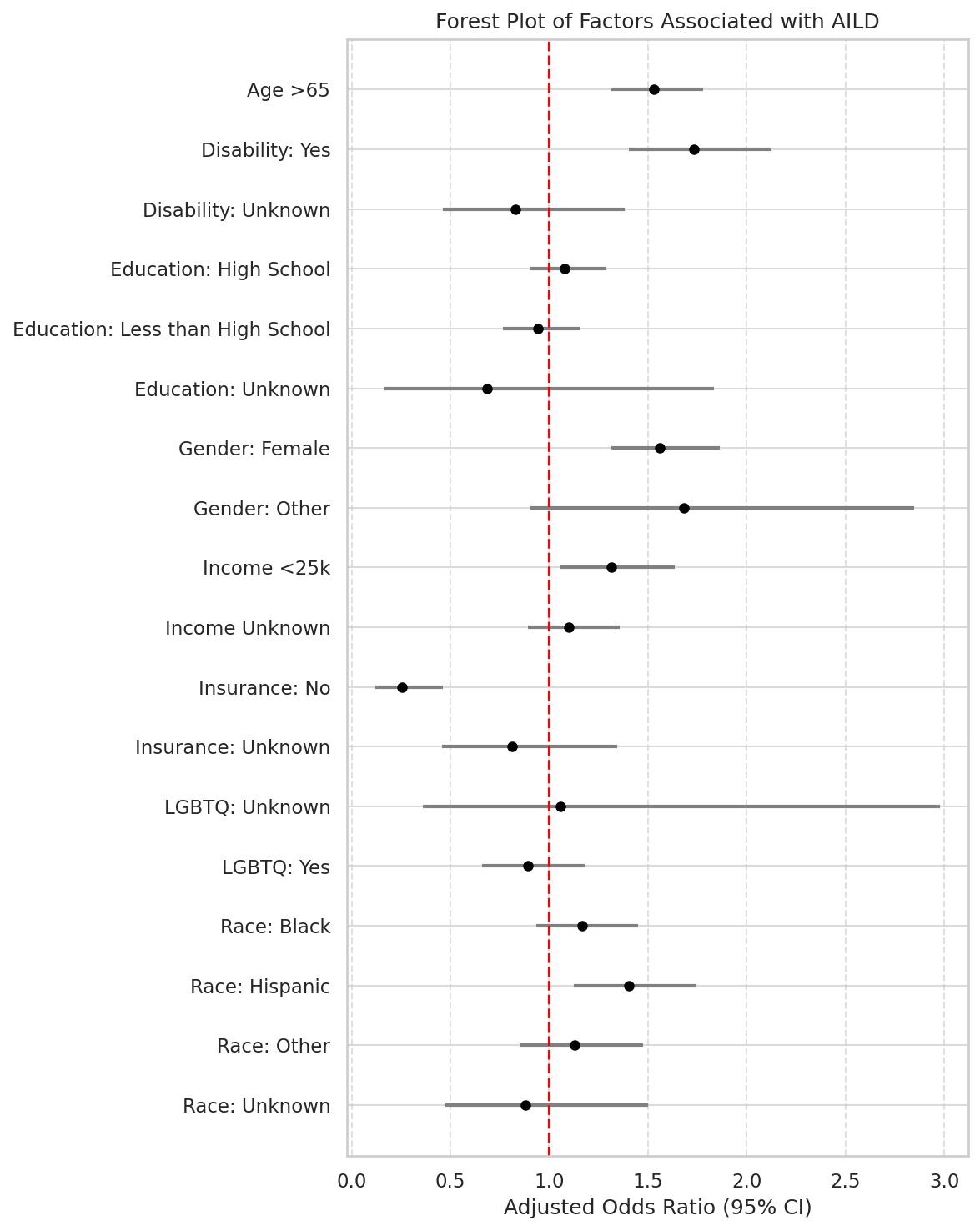Sunday Poster Session
Category: Liver
P1498 - The Unequal Burden: Insights Into Autoimmune Liver Disease in US Minority Populations from All of Us
Sunday, October 26, 2025
3:30 PM - 7:00 PM PDT
Location: Exhibit Hall

Kanwal Bains, MD
Banner - University of Arizona Tucson
Tucson, AZ
Presenting Author(s)
Kanwal Bains, MD1, Nathan Cunicelli, PhD2, Ravi Teja Pasam, MBBS, MPH3
1Banner - University of Arizona Tucson, Tucson, AZ; 2University of Arizona, Tucson, AZ; 3Wentworth-Douglass Hospital, Dover, NH
Introduction: Autoimmune liver diseases (AILDs), including autoimmune hepatitis (AIH), primary biliary cholangitis (PBC), and primary sclerosing cholangitis (PSC), are chronic inflammatory conditions. Minority groups face higher health disparities, per the CDC. We conducted a cross-sectional analysis of AILD burden using the NIH’s All of Us (AoU) database, which focuses on underrepresented populations.
Methods: We analyzed data from the NIH’s All of Us Research Program, including adults (age >18) with electronic health records and SNOMED codes for autoimmune hepatitis (408335007), primary biliary cholangitis (4135822), primary sclerosing cholangitis (4058821), or autoimmune liver disease (4340391). Chi-square or Fisher’s exact tests were used for comparison between groups with and without AILD. Marginal and adjusted odds ratios were estimated via simple and multivariable logistic regression, adjusting for sociodemographics and key comorbidities. Analyses were conducted on the AoU Jupyter platform using R version 4.4.0.
Results: Out of 410,138 participants, 764 (0.19% or 186 per 100,000) had an AILD diagnosis. Compared to those without AILD, these individuals were more likely to be female (73.8% vs. 60.0%, p< 0.01), under 65 years (45.8% vs. 33.1%, p< 0.01), and have an annual income below $25,000 (23.8% vs. 20.0%, p< 0.03). Race-specific prevalence was highest among White participants (0.21%; 95% CI: 0.17–0.24), followed by Black (0.17%) and Other racial groups (0.16%).
AILD was significantly associated with several comorbidities, including psoriasis (4.8% vs. 1.6%), atopic dermatitis (3.9% vs. 1.5%), rheumatoid arthritis (9.8% vs. 1.9%), Sjögren’s syndrome (8.5% vs. 0.8%), systemic lupus erythematosus (10.0% vs. 0.9%), celiac disease (3.7% vs. 0.5%), systemic scleroderma (4.3% vs. 0.2%), and hypothyroidism (25.8% vs. 7.5%) (all p< 0.01).
Multivariable logistic regression, adjusting for sociodemographics and comorbidities, showed increased odds of AILD among participants >65 years (AOR 1.52; 95% CI: 1.31–1.77), Hispanic (AOR 1.40; 95% CI: 1.13–1.75), disabled (AOR 1.73; 95% CI: 1.41–2.12), and female (AOR 1.56; 95% CI: 1.31–1.85).
Discussion: Our findings highlight significant disparities in the prevalence and diagnosis of autoimmune liver diseases (AILDs), underscoring the urgent need for greater inclusion of underrepresented populations in epidemiological research to advance health equity and improve care delivery.

Figure: Adjusted Odds Ratios for Autoimmune Liver Disease (AILD) by Sociodemographic and Clinical Factors
Disclosures:
Kanwal Bains indicated no relevant financial relationships.
Nathan Cunicelli indicated no relevant financial relationships.
Ravi Teja Pasam indicated no relevant financial relationships.
Kanwal Bains, MD1, Nathan Cunicelli, PhD2, Ravi Teja Pasam, MBBS, MPH3. P1498 - The Unequal Burden: Insights Into Autoimmune Liver Disease in US Minority Populations from All of Us, ACG 2025 Annual Scientific Meeting Abstracts. Phoenix, AZ: American College of Gastroenterology.
1Banner - University of Arizona Tucson, Tucson, AZ; 2University of Arizona, Tucson, AZ; 3Wentworth-Douglass Hospital, Dover, NH
Introduction: Autoimmune liver diseases (AILDs), including autoimmune hepatitis (AIH), primary biliary cholangitis (PBC), and primary sclerosing cholangitis (PSC), are chronic inflammatory conditions. Minority groups face higher health disparities, per the CDC. We conducted a cross-sectional analysis of AILD burden using the NIH’s All of Us (AoU) database, which focuses on underrepresented populations.
Methods: We analyzed data from the NIH’s All of Us Research Program, including adults (age >18) with electronic health records and SNOMED codes for autoimmune hepatitis (408335007), primary biliary cholangitis (4135822), primary sclerosing cholangitis (4058821), or autoimmune liver disease (4340391). Chi-square or Fisher’s exact tests were used for comparison between groups with and without AILD. Marginal and adjusted odds ratios were estimated via simple and multivariable logistic regression, adjusting for sociodemographics and key comorbidities. Analyses were conducted on the AoU Jupyter platform using R version 4.4.0.
Results: Out of 410,138 participants, 764 (0.19% or 186 per 100,000) had an AILD diagnosis. Compared to those without AILD, these individuals were more likely to be female (73.8% vs. 60.0%, p< 0.01), under 65 years (45.8% vs. 33.1%, p< 0.01), and have an annual income below $25,000 (23.8% vs. 20.0%, p< 0.03). Race-specific prevalence was highest among White participants (0.21%; 95% CI: 0.17–0.24), followed by Black (0.17%) and Other racial groups (0.16%).
AILD was significantly associated with several comorbidities, including psoriasis (4.8% vs. 1.6%), atopic dermatitis (3.9% vs. 1.5%), rheumatoid arthritis (9.8% vs. 1.9%), Sjögren’s syndrome (8.5% vs. 0.8%), systemic lupus erythematosus (10.0% vs. 0.9%), celiac disease (3.7% vs. 0.5%), systemic scleroderma (4.3% vs. 0.2%), and hypothyroidism (25.8% vs. 7.5%) (all p< 0.01).
Multivariable logistic regression, adjusting for sociodemographics and comorbidities, showed increased odds of AILD among participants >65 years (AOR 1.52; 95% CI: 1.31–1.77), Hispanic (AOR 1.40; 95% CI: 1.13–1.75), disabled (AOR 1.73; 95% CI: 1.41–2.12), and female (AOR 1.56; 95% CI: 1.31–1.85).
Discussion: Our findings highlight significant disparities in the prevalence and diagnosis of autoimmune liver diseases (AILDs), underscoring the urgent need for greater inclusion of underrepresented populations in epidemiological research to advance health equity and improve care delivery.

Figure: Adjusted Odds Ratios for Autoimmune Liver Disease (AILD) by Sociodemographic and Clinical Factors
Disclosures:
Kanwal Bains indicated no relevant financial relationships.
Nathan Cunicelli indicated no relevant financial relationships.
Ravi Teja Pasam indicated no relevant financial relationships.
Kanwal Bains, MD1, Nathan Cunicelli, PhD2, Ravi Teja Pasam, MBBS, MPH3. P1498 - The Unequal Burden: Insights Into Autoimmune Liver Disease in US Minority Populations from All of Us, ACG 2025 Annual Scientific Meeting Abstracts. Phoenix, AZ: American College of Gastroenterology.
